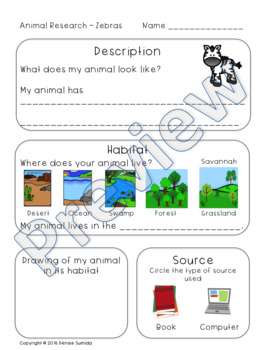Kindergarten Animal Research Bundle - Description Habitat Diet Facts Worksheets
- Zip
Products in this Bundle (4)
Description
Looking for a primary note taking lesson on animals? This beginning note taking lesson guides students to research the description, habitat, diet, and fun facts of land and ocean animals. It is perfect for Kindergarten or First Grade students.
Land Animal note taking sheets include:
- Alligators
- Bears
- Birds
- Chameleons
- Coyotes
- Deer
- Ducks
- Eagles
- Elephants
- Frogs
- Giraffes
- Gorillas
- Hedgehogs
- Hippopotamuses
- Jack Rabbits
- Kangaroos
- Lions
- Meerkats
- Monkeys
- Owls
- Parrots
- Raccoons
- Reindeer
- Rhinos
- Snakes
- Squirrels
- Tigers
- Turtles
- Zebras
- A blank note taking sheet is also provided for customization
Ocean Animal note taking sheets include:
- Clams
- Clown Fish
- Corals
- Crabs
- Dolphins
- Eels
- Hermit Crabs
- Humpback Whales
- Jellyfish
- Lobsters
- Manatees
- Marlins
- Octopus
- Otters
- Pufferfish
- Sea Horses
- Seals
- Sharks
- Squid
- Starfish
- Stingrays
- Turtles
- A blank note taking sheet is also provided for customization
Additional Features:
- Tips for teaching the research lesson
- Worksheets provided with color and black/white versions of the clipart
Pictures of various habitats and foods are included for students to circle to help them choose the appropriate answer to write down. Boxes for the students to draw their animal in its habitat and the animal while eating are also featured in these lessons.
Students can be assigned different animals to research or selected animals can be studied in a whole group setting.
Students should use PebbleGo, online encyclopedias, ebooks or regular books to find the answers to the research boxes. A source box is also included for students to indicate the type of source used.
What do teachers have to say about this resource?
Comments taken from the individual product listings
"Loved including this resource in our research project!"
"This was so great to have to use with our habitat unit."
"This was a great resource to use with PebbleGo!"
"Fantastic 2nd Resource to go along with their research! Thank You!"
***Note- this product includes pages that have been designed for students to use as templates for note taking while researching their topic. It does NOT include information about the habitats or animals. This a zip file, please be sure you are able to open zipped files before you download this product.
If you have ANY problems or questions, please email me at readingunderthehulamoon@gmail.com and I'll be happy to help you.
Don't forget to leave feedback to earn you points on TPT products. I appreciate the feedback!
Also, click here to follow me and be notified when I post new products.
I'm committed to continual improvement. This resource was updated and enhanced on November 3, 2020.





